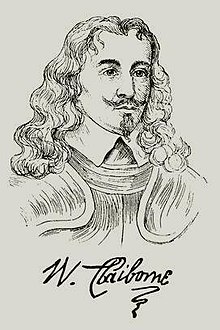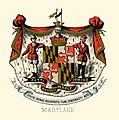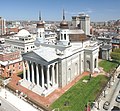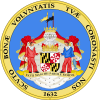Portal:Maryland
|
Maryland Portal
|
Baltimore Task Force
|
Frederick Task Force
|
Montgomery Task Force
|
WikiProject Maryland
|
|
Main page
|
Discussion
|
Introduction Maryland (US: /ˈmɛrɪlənd/ ⓘ MERR-il-ənd) is a state in the Mid-Atlantic region of the United States. The state borders Virginia to its south, West Virginia to its west, Pennsylvania to its north, Delaware to its east, the Atlantic Ocean, and the national capital of Washington, D.C. With a total area of 12,407 square miles (32,130 km2), Maryland is the ninth-smallest state by land area, and its population of 6,177,224 ranks it the 18th-most populous state and the fifth-most densely populated. Maryland's capital is Annapolis, and the most populous city is Baltimore. Occasional nicknames include Old Line State, the Free State, and the Chesapeake Bay State. It is named after Henrietta Maria, the French-born queen of England, Scotland, and Ireland during the 17th century. Maryland's coastline was first explored by Europeans in the 16th century. Prior to that, it was inhabited by several Native American tribes, mostly the Algonquian peoples and, to a lesser degree, Iroquoians and Siouans. As one of the original Thirteen Colonies, Maryland was founded by George Calvert, 1st Baron Baltimore, a Catholic convert who sought to provide a religious haven for Catholics persecuted in England. In 1632, Charles I of England granted Lord Baltimore a colonial charter, naming the colony after his wife, Henrietta Maria. Unlike the Pilgrims and Puritans, Lord Baltimore envisioned a colony where people of different religious sects would coexist under the principle of toleration. In 1649, the Maryland General Assembly passed an Act Concerning Religion, which enshrined this principle by penalizing anyone who "reproached" a fellow Marylander based on religious affiliation. Nevertheless, religious strife was common in the early years, and Catholics remained a minority, albeit in greater numbers than in any other English colony. Maryland's early settlements and population centers clustered around rivers and other waterways that empty into the Chesapeake Bay. Its economy was heavily plantation-based and centered mostly on the cultivation of tobacco. Demand for cheap labor from Maryland colonists led to the importation of numerous indentured servants and enslaved Africans. In 1760, Maryland's current boundaries took form following the settlement of a long-running border dispute with Pennsylvania. Maryland was an active participant in the events leading up to the American Revolution, and by 1776, its delegates signed the Declaration of Independence. Many of its citizens subsequently played key political and military roles in the war. Although then a slave state, Maryland remained in the Union during the American Civil War, its strategic location giving it a significant role in the conflict. After the Civil War, Maryland took part in the Industrial Revolution, driven by its seaports, railroad networks, and mass immigration from Europe. Since the 1940s, the state's population has grown rapidly, to approximately six million residents, and it is among the most densely populated U.S. states. , Maryland had the highest median household income of any state, owing in large part to its proximity to Washington, D.C., and a highly diversified economy spanning manufacturing, retail services, public administration, real estate, higher education, information technology, defense contracting, health care, and biotechnology. Maryland is one of the most multicultural states in the country; it is one of the six states where non-Whites compose a majority of the population, with the fifth-highest percentage of African Americans, and high numbers of residents born in Africa, Asia, Central America, and the Caribbean. The state's central role in U.S. history is reflected by its hosting of some of the highest numbers of historic landmarks per capita. (Full article...) This is a Featured article, which represents some of the best content on English Wikipedia..
Ruth Elizabeth "Bazy" Tankersley (née McCormick, formerly Miller; March 7, 1921 – February 5, 2013) was an American breeder of Arabian horses and a newspaper publisher. She was a daughter of U.S. Senator Joseph Medill McCormick. Her mother was progressive Republican U.S. Representative Ruth Hanna McCormick, making Tankersley a granddaughter of Senator Mark Hanna of Ohio. Although Tankersley was involved with conservative Republican causes as a young woman, including a friendship with Senator Joseph McCarthy, her progressive roots reemerged in later years. By the 21st century, she had become a strong supporter of environmental causes and backed Barack Obama for president in 2008. Tankersley's father died when she was a child. When her mother remarried, the family moved to the southwestern United States, where Tankersley spent considerable time riding horses. She became particularly enamored of the Arabian breed after she was given a part-Arabian to ride. At the age of 18, she began working as a reporter for a newspaper published by her mother. She later ran a newspaper in Illinois with her first husband, Peter Miller. In 1949, she became the publisher of the conservative Washington Times-Herald. That paper was owned by her uncle, the childless Robert McCormick, who viewed Tankersley as his heir until the two had a falling out over editorial control of the newspaper and her relationship with Garvin Tankersley, who became her second husband. After The Washington Post absorbed the Times-Herald, she shifted to full-time horse breeding. (Full article...)General imagesIn the news
On this day...This is a Good article, an article that meets a core set of high editorial standards.
 William Claiborne also, spelled Cleyburne (c. 1600 – c. 1677) was an English pioneer, surveyor, and an early settler in the colonies/provinces of Virginia and Maryland and around the Chesapeake Bay. Claiborne became a wealthy merchant and planter, as well as a major political figure in the mid-Atlantic colonies. He featured in disputes between the colonists of Virginia and the later settling of Maryland, partly because of his earlier trading post on Kent Island in the mid-way of the Chesapeake Bay, which provoked the first naval military battles in North American waters. Claiborne repeatedly attempted and failed to regain Kent Island from the Maryland Calverts, sometimes by force of arms, after its inclusion in the lands that were granted by a 1632 Royal Charter to the Calvert family. Kent Island had become Maryland territory after the surrounding lands were granted to Sir George Calvert, first Baron and Lord Baltimore (1579–1632) by the reigning King of England, Charles I (1600–1649; reigned from 1625 until his execution in 1649). Claiborne was an Anglican, a Puritan sympathizer, and deeply resentful of the Calverts' Catholicism. He was one of the signers, along with Virginia Governor John Pott, Samuel Matthews, and Roger Smyth, of a letter to the King's Privy Council, dated 30 November 1629, complaining that Lord Baltimore refused to take the Oath of Allegiance and Supremacy to the Church of England. He sided with Parliament during the English Civil War of 1642–1651 and was appointed to a commission charged with subduing and managing the Province of Virginia and Province of Maryland, both British colonies at the time. He played a role in the submission of Virginia to parliamentary rule in this period. Following the restoration of the English monarchy in 1660, he retired from involvement in the politics of the Virginia colony. He died around 1677 at his plantation, Romancoke, on Virginia's Pamunkey River. According to historian Robert Brenner, "William Claiborne may have been the most consistently influential politician in Virginia throughout the whole of the pre-Restoration period". (Full article...)Selected article -
The Washington, Brandywine & Point Lookout Railroad (WB&PL) (originally, the Southern Maryland Railroad) was an American railroad that operated in southern Maryland and Washington, D.C., from 1881 to 1954. Its single-track line connected Patuxent River in Maryland to the Pennsylvania Railroad. It operated in and out of bankruptcy and changed its name numerous times. (Full article...)
Did you know?

SubcategoriesSelect [+] to view subcategories
TopicsRelated portalsAssociated WikimediaThe following Wikimedia Foundation sister projects provide more on this subject:
Discover Wikipedia using portals |























































